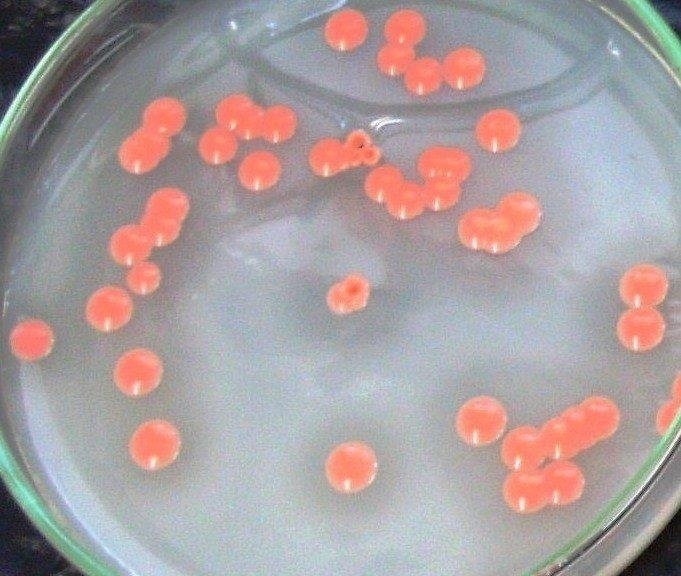

Colonies of the yeast Rhodotorula mucilaginosa on a culture plate of Sabouraud agar-milk medium (10%) (photo: EEL-USP)
Research says that yeasts found at the South Pole may produce proteases that have economic value and applications in various industries.
Research says that yeasts found at the South Pole may produce proteases that have economic value and applications in various industries.

Colonies of the yeast Rhodotorula mucilaginosa on a culture plate of Sabouraud agar-milk medium (10%) (photo: EEL-USP)
By Fabio Reynol
Agência FAPESP – The manufacture of detergents, cosmetics, food, medicines and many other chemical products depends on processes carried out by enzymes, which are organic catalysts that enable many chemical reactions. Among the enzymes of interest to industry, the most readily employed are the proteases, which account for 60% of the world’s enzyme market.
One strategy for discovering new compounds is to look for microorganisms known as “extremophiles,” which produce compounds, in extreme climates. For this reason, in March 2012, the team led by Prof. Maria das Graças de Almeida de Felipe of the Lorena School of Engineering at the University of São Paulo (EEL-USP), began the FAPESP-funded regular research project “Establishment of cultivation conditions of yeast isolated from Antarctica aimed at protease production,” which was completed this year.
“Our expectation was that these microorganisms found in extreme environments, with restrictive conditions of climate, could produce enzymes with special characteristics for use in industrial bioprocesses,” said Almeida de Felipe.
The South Pole fungi were stored in the Brazilian Collection of Environmental and Industrial Microorganisms, which belongs to the Multidisciplinary Center for Chemical, Biological and Agricultural Research at the University of Campinas (CPQBA-Unicamp).
All of the material, which includes 350 fungi, is part of an earlier project, titled “Biological Exploitation of Antarctic-derived Fungi,” coordinated by Prof. Lara Durães Sette of the Biosciences Institute at the São Paulo State University (IB-Unesp), Rio Claro (SP) campus.
The first project had already begun a study to explore other enzymes in addition to the proteases produced by the Antarctic fungi. The work of Sette’s team was performed from 2011 to 2013 and demonstrated that there could be several enzymes in the material of significant interest to industry.
Proteases are important not only as biological catalysts but also because they are part of the formulation of detergents, flavorings and other fine chemical products, according to the USP researcher. “The Antarctic microorganisms may not originally come from that continent; once taken there, they adapted to the extreme climatic and geographic conditions,” said Almeida de Felipe.
That is why the team already expected that the microorganisms would produce molecules with special characteristics, such as highly stable proteases that could be maintained at a wide range of temperatures, which could allow their application in an extensive variety of industrial sectors.
Almeida de Felipe’s team used the collection of fungi from the CPQBA, or a set of 99 potential protease-producing yeasts. The material was sent to the Lorena campus of USP for laboratory cultivation. Among the 99 samples, 14 displayed a halo around their colonies when in contact with milk. The presence of the halo indicated degradation of the milk proteins and thus the presence of proteases.
Of the 14 productive yeasts, one, Rhodotorula mucilaginosa, drew the attention of the researchers because of its productivity. The taxonomic tests that identified the microorganism were conducted in parallel with the project led by Sette.
“We knew that we had microorganisms from Antarctica, and we knew the locations that they were extracted from, but we did not know what they were. Therefore, the taxonomic work needed to be carried out alongside our work,” Almeida de Felipe said.
The species found produces a high-quality molecule that was shown to be stable along a wide temperature range, which would prevent damage during an industrial process in the event of a power outage, for example.
When subjected to slight temperature variations, other enzymes lead to a loss of enzymatic activity, according to the USP researcher.
The yeast selected reaches its maximum activity at a temperature of 50°C and pH 5, which reinforces the hypothesis that these microorganisms are not native to Antarctica and therefore have developed adaptation strategies.
Orange pigment
Another subproduct of Rhodotorula is its orange pigment, which prompted continued investigations to assess the production of the molecule and its possible applications.
The research group believes that the yeast can serve as a basis for a large variety of natural products, ranging from natural dyes and substitutes for synthetic dyes to biosurfactants, or agents that are capable of altering the surface properties of a liquid.
The pigment even changes color as the temperature changes, which offers a world of application opportunities, such as use as a biosensor for temperature.
This study of proteases became the responsibility of doctoral candidate Luciana Cristina Silveira Chaud and resulted in the thesis “Evaluation of protease production by fungi isolated in Antarctica,” defended August 8, 2014, at the EEL-USP under the mentorship of Almeida de Felipe.
“The thesis examination board also realized the potential of the protease discovery and suggested continuation of the studies, including analytical analysis of the microorganisms,” the professor said.
To continue the work, the project “Marine and Antarctic Biotechnology: Microbial Enzymes and their Applications,” coordinated by Sette, with participation by Almeida de Felipe, began in April 2014.
The project includes studies using these fungi to produce enzymes, as well as the characterization, upscaling and technological application of these enzymes.
“We’ve had major discoveries in recent years, and there are very promising prospects that should provide innovation through biodiversity-based products,” Almeida de Felipe said.
Republish
The Agency FAPESP licenses news via Creative Commons (CC-BY-NC-ND) so that they can be republished free of charge and in a simple way by other digital or printed vehicles. Agência FAPESP must be credited as the source of the content being republished and the name of the reporter (if any) must be attributed. Using the HMTL button below allows compliance with these rules, detailed in Digital Republishing Policy FAPESP.





